A Field Guide To Amazon Advertising
Columnist David Rekuc walks you through Amazon’s ad formats and explains how you can achieve the best return on investment for each one.
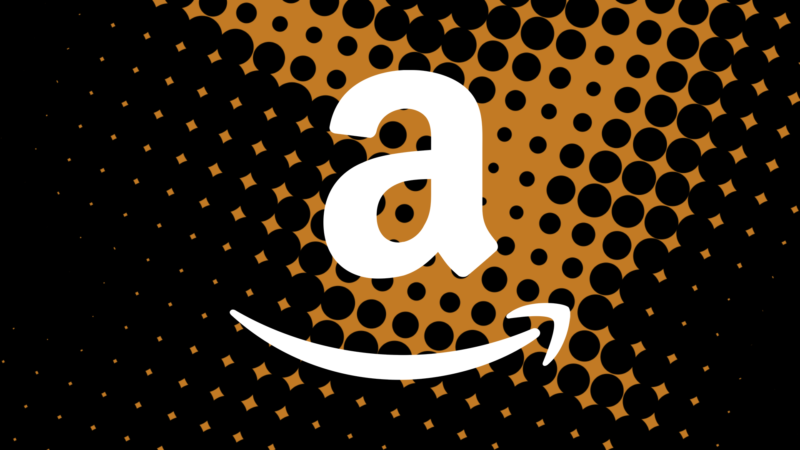 With the holiday season fast approaching, many retailers and brands are looking for new ways to squeeze a little more out of the once-a-year consumer bonanza. Marketplace advertising is a great low-effort, high-impact option that often goes overlooked.
With the holiday season fast approaching, many retailers and brands are looking for new ways to squeeze a little more out of the once-a-year consumer bonanza. Marketplace advertising is a great low-effort, high-impact option that often goes overlooked.
In this article, I’m going to focus on Amazon’s two platforms and how to maximize your ROI on both.
Amazon Product Ads (Or Text Ads)
This section is easy, since they’re both now defunct. I’m including this in the guide so you don’t wind up chasing your tail trying to find something that no longer exists.
These ads were product feed-driven (like Google Shopping or Nextag) and drove users who clicked the ads off Amazon.com. The idea was to find in-market shoppers and drive them to your site. However, it seems the powers that be decided to invest in ads for products sold on Amazon.com.
Which brings us to…
Seller Central Advertising
Often called Amazon Sponsored Products, this section refers to ads available to Amazon’s third-party sellers.
These ads function most similarly to Google Shopping. That is to say, your “ad” is simply your product listing. It uses the same data as a product you’re selling, and there’s no additional creative to design or upload.
For instance, one wine cooler product page looks like this:

Koldfront’s ad for the same product resizes the default image and uses the first 35 characters of the title to create a headline:
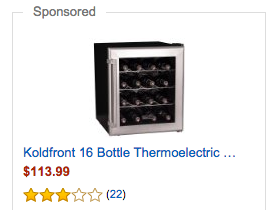
It’s important to note that if the product you’ve selected for the ad is out of stock or you don’t have the buy box, the ad won’t run. This is a really nice feature, and it allows you to run these campaigns over a longer time period with peace of mind.
You are then given two options for targeting:

Automatic targeting. In almost no scenario do I prefer automatic targeting in favor of having the controls myself. The same goes for targeting on Amazon.
Nevertheless, this option can be useful to discover relevant terms and then track your organic performance. So it can be helpful for a keyword discovery campaign, or even a really easy campaign when you’re just getting started.
Manual targeting. After clicking through, you’ll have the ability to add keywords on broad, phrase and exact match types. Amazon also recently introduced negative keywords.
Marketing professionals who are familiar with Google AdWords paid search campaigns will feel fairly at home with these options.
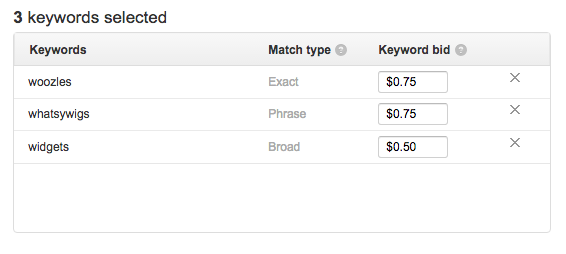
Bid management and reporting are both at the keyword level to help you optimize your campaigns. For products that are just starting out on Amazon, I find this is a great way to test the waters and uncover relevant keywords. You should be looking for high conversion, as well as high volume.
Smart Uses
Since you’ve got all the flexibility of keyword advertising at your fingertips, there are obviously plenty of ways you can use these ads. Here are a few of the ways I find them most effective:
Advertising for the generic terms:
No brands mentioned — just give ‘em what they’re looking for. Dishwasher, bath towel and so on. The more specific you get, the better your ROI typically will be. The less specific you get, the wider the audience is.
Advertising for a competitor’s terms:
Instead of advertising for “flat screen TV,” maybe you target “Sony TV” because your product is cheaper and better than a popular Sony model.
In this search for Sony TV, Axess is advertising their 22-inch flat screen:

This is a good place to mention Amazon reviews, which can make or break a product’s sales. Consumers place a ton of trust in the site’s reviews.
If the name brand with a lot of search volume has poor reviews, a less popular brand with great reviews can steal the sale. (Unfortunately for Axess, this is not the case here.)
Advertising as an upsell or cross-sell:
Let’s say I sell iPhone cases. Instead of going after OtterBox or some large case maker, I might try to hook the user before they’re even in the market.
In this case, I would bid on terms like “iPhone 6.” Take a look at these ads running against a search for that term:
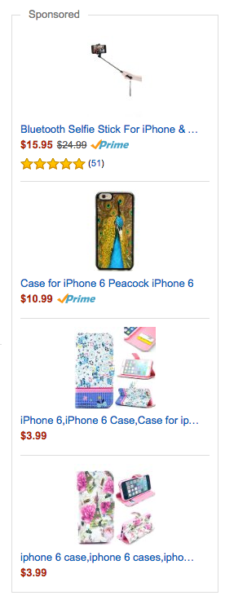
There are various other ways you can target your ads, but these three usually provide the best return for our clients.
Amazon Marketing Services (AKA Vendor Ads)
One of the many perks of selling to Amazon as a vendor is having access to its vendor-only advertising platform. Strangely enough, these campaigns are both more powerful in some ways and also missing some features available on seller campaigns. Let’s take a closer look.

Sponsored Products
Sponsored Products, which are relatively new, allow you to promote individual products using keyword targeting.
Per Amazon’s own display, these ads should appear below the search results. However, I have seen evidence that there may be some experimentation going on with their placement on the search results page.

These campaigns drive an excellent ROI and can give a best-selling product a ton of visibility. There is, however, a key drawback to Sponsored Products ads: The ads can only be targeted using broad keywords.
Broad keywords present a big problem when trying to scale an account to its maximum potential. Most vendors specialize in one industry; they have a suite of products that covers a given need. That means there is almost always overlap and cannibalization between campaigns for different products.
Headline Search Ads
The headline search ads appear above the results as a banner.
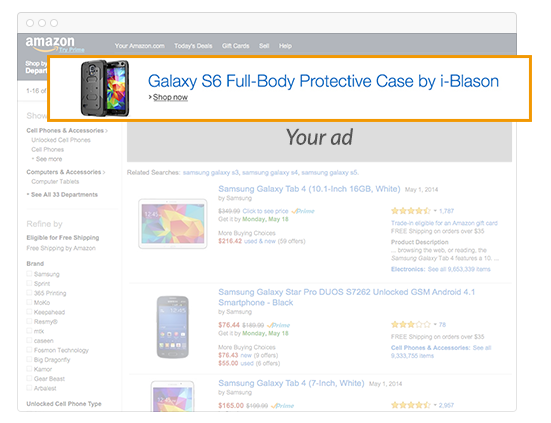
With headline ads, you can direct users to nearly any page on Amazon, including a brand page. I find mirroring the search term while incorporating your brand usually results in the best return on investment.
For instance, here’s a great ad for Galaxy S6 cases on Amazon:

The ad isn’t just about Spigen cases in general; instead, it calls out their S6 case collection. The ad directs the user to a landing page for a search for “galaxy s6 case” with the Spigen brand filter ticked.
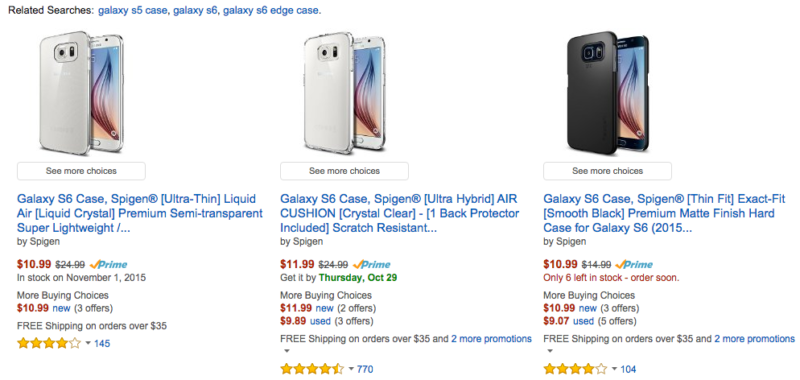
The result is a landing page featuring 53 products — all are Spigen S6 cases with great reviews.
The reporting you get for these kinds of campaigns looks like this:

The reporting is usually delayed up to 48 hours, so if you’re running a time-sensitive campaign, I find the detail page view (DPV) to clicks ratio is really important.
Keep in mind, a click here means a single click on the ad. A detail page view means the users made it to looking at the detail page for one particular product.
If we’re sending them to a search page full of what they’re looking for, they should be browsing a little bit to find the “right” one. So in almost all of my successful headline search campaigns, the DPV to clicks ratio is above 1.
When this ratio drops below 1, it usually means the user doesn’t think the landing page they’re directed to is relevant to their search. It means they clicked the ad but saw no reason to look closer at one (or more) options.
You’ll also have access to reporting on a keyword level. However, the DPV metric isn’t available at the keyword level.
It’s also important to note that the “Total Sales” value you see is the retail value of the product, not the wholesale value. This means this will be a larger number than vendors will actually experience as a lift in sales.
Product Display Ads
Unlike the other ads in Amazon’s advertising arsenal, these ads aren’t targeted with keywords, but rather by selecting where you want your product(s) to appear.
For example, take a look at this ad for a bike helmet that runs on the product detail page of a popular road bike:
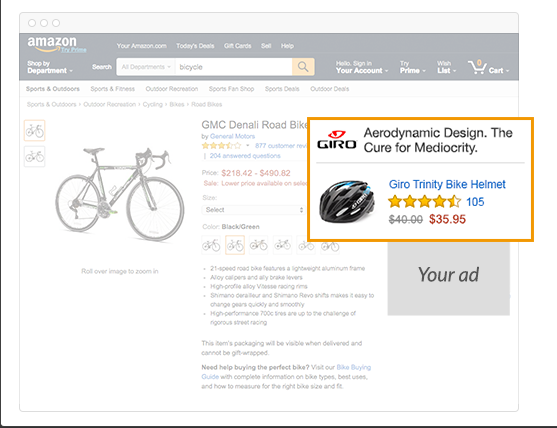
When you’re building this ad, you’ll see a search box you can use to find relevant products. You can target relevant complementary products, like the example above. We also like this ad unit for targeting competitors’ products.
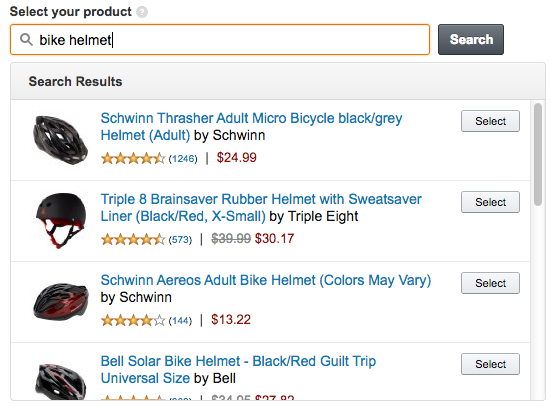
You can also search by UPC or ASIN if you already know your competitors’ products. At Ripen (my employer), we typically build a list of competitor ASINs in Excel first, quickly search each and select the product when building our ads.
For these ads, you won’t get reporting on the product target level, only for the entire campaign. Unfortunately, this makes it hard to determine what products are driving a good ROI and which aren’t doing as well. You’ll need to compensate by smartly grouping your products into targeted campaigns.
We typically see a good return on these ads, but at a lower volume than with headline search or Sponsored Products ads.
Wrapping It Up
Amazon’s increased focus on advertising has opened up new opportunities that can yield a stellar return on investment — but the structure of Amazon’s two ad platforms requires you to think out what you want to achieve with a campaign prior to creating it.
I find Amazon advertising especially appealing to brands that already have direct relationships with the site.
On the other hand, Amazon advertising empowers merchants to help push sales in a measurable way that is rarely available on other channels. With some smart structuring and careful analysis, there is a ton of potential for merchants willing to invest in the mega-retailer’s relatively young ad platforms.
Editor’s note: This post has been updated to correct an earlier misstatement about Sponsored Products. The Sponsored Products Ads do pause when you lose the buy box, and they will stop running for products that are out of stock.
Contributing authors are invited to create content for MarTech and are chosen for their expertise and contribution to the search community. Our contributors work under the oversight of the editorial staff and contributions are checked for quality and relevance to our readers. MarTech is owned by Semrush. Contributor was not asked to make any direct or indirect mentions of Semrush. The opinions they express are their own.
Related stories